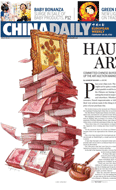Art
Creating Beijing enamel art
Updated: 2011-02-15 13:26
(Chinaculture.org)
 |
Step 1 Creation of shape from brass or copper
Step 2 Shaping and soldering on of enamel cell shapes in patterns covering surface. The wires used are made of copper.
Step 3 Initial fill of cells with multiple colors of enamel, fire in kiln. Each step is created by an artisan in that expertise.
Step 4 When firing, the enamel contracts, so more color fill is needed - 3 to 4 times until the surface is even, smooth and without depressions. The enamel here still looks glossy.
Step 5 Sand and polish surface so level and uniform. Cells and enamel should look melded into one. You'll notice the finish is dull at this point. It still must be polished.
Step 6 Polish. and coat with electro-plating medium as prep for metallic accenting. Electroplate outer portion of cells and any other desired areas.
Step 7 Final polishing and cleaning. A bead can take 5 hours from start to finish. Something like a vessel can take a week.
 |
The skill and workmanship have been handed down from the Ming Dynasty. Since the founding of new China, quite a number of new varieties have been created. It enjoys a high reputation both at home and abroad with most of its products for export.
Three styles of cloisonné are most often seen: concave, convex, and flat. The finishing method determines this final appearance. With concave cloisonné the cloisons are not completely filled. Capillary action causes the enamel surface to curve up against the cloisonné wire when the enamel is molten, producing a concave appearance. Convex cloisonné is produced by overfilling each cloison, at the last firing. This gives each color area the appearance of slightly rounded mounds. Flat cloisonné is the most common. After all the cloisons are filled the enamel is ground down to a smooth surface with lapidary equipment, using the same techniques as are used for polishing cabochon stones. The top of the cloisonné wire is polished so it is flush with the enamel and has a bright luster. Some cloisonné enamel is electroplated with a thin film of gold, which will not tarnish as silver does.
All the products are beautiful and elegant in molding, brilliant and dazzling in colors and splendid and graceful in design. It is a famous local handicraft in the Beijing region.
E-paper

Ear We Go
China and the world set to embrace the merciful, peaceful year of rabbit
Preview of the coming issue
Carrefour finds the going tough in China
Maid to Order
Specials

Mysteries written in blood
Historical records and Caucasian features of locals suggest link with Roman Empire.

Winning Charm
Coastal Yantai banks on little things that matter to grow

New rules to hit property market
The State Council launched a new round of measures to rein in property prices.
